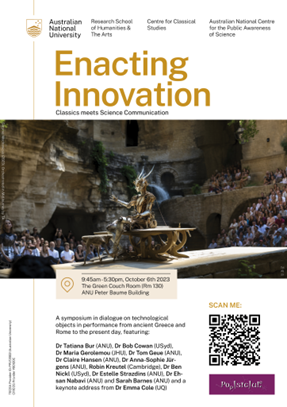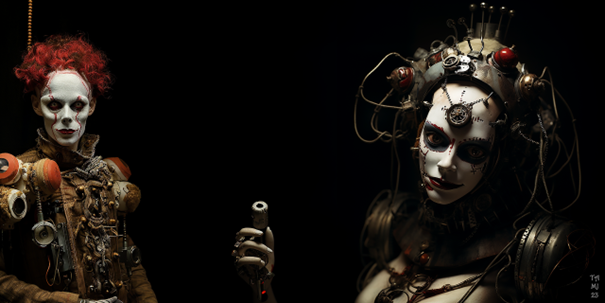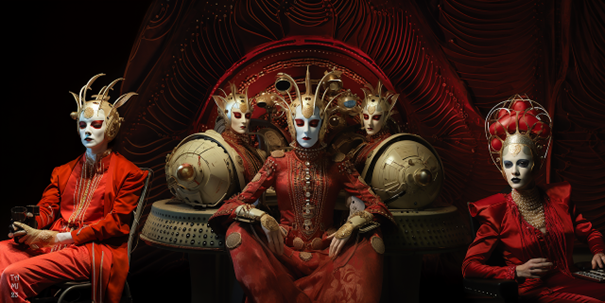Text: TA in conversation with Tatiana Bur, Sarah Barnes and Anna-Sophie Jürgens | Section: Interviews
Overview: In the first of this two-part interview, AI-artist TA talks to us about how he defines AI-art, and the potentials of this new, and controversial, artistic medium. TA shares his experience with readers from his initial reactions to the technology through to his embracing of the algorithms and resultant collaborations with academic researchers from various disciplines including Earth Sciences, Science Communication and Classical Studies. TA’s wealth of experience working with AI tools for creative expression leads him to reflect not just on how AI-artists and academics can work together, but also on the ways in which art and scientific knowledge can be co-constructed.
TA, you are a Canberra-based visual AI artist who regularly collaborates with scientists and researchers from different fields, such as Earth Sciences, Science Communication and Classical Studies, including us. Your work has been published in academic journals and news feeds (e.g. the Deutsche GeoForschungsZentrum [GFZ] or the Journal of Science & Popular Culture) as well as books (e.g. in the Springer’s series Southern Space Studies: Outer Space and Popular Culture) and many online articles. All of this is very interesting for w/k, and in this article, we would like to discuss the artistic concepts behind your collaborations with researchers and the power – pitfalls and promises – of AI art to communicate academic knowledge.
Wild monkeys couldn’t keep me away! … maybe …
AI ART
TA, how do you define AI art, and how do you position yourself in this fascinating and topical (yet polarising) contemporary space of technology-empowered creative expression?
My initial reaction to the reality of AI-engineered imagery was a somewhat frustrated, negative one, at least for the first thirty minutes or so. Those free trial orchestrated images immediately overwhelmed my aesthetic cognition such that it catalysed and solidified my latent despair for the hours of personal effort I had, up to that point, expended to attain a decidedly average artistic ability. It felt as if AI technology had erased, in a single iteration of its algorithm, what small artistic niche I might have been able to carve for myself out of the mountainous pile of human artistic expression. Within that first half hour, cohesive despair gave way to a fairly obvious fundamental choice: either to whinge and moan about AI image technology being the sudden death of much of my hitherto unremarkable artistic efforts, or to step aside from that tumour of self-pity, purchase a MidJourney subscription, and use it as an entry point into the brave new world of AI-orchestrated creativity. AI technology-empowered creative expression for me became a means of achieving artistic goals that I had previously abandoned as beyond my technical ability – using AI as a tool to echo a creative cadence that once I did not have the facility to express but with which am now developing a palpable subharmonic resonance.

What do you think of the fact that visual AI art is based on words – on prompts?
Hammering images out of the AI it is quite literally the reverse function of a picture is worth a thousand words. Word combinations, conceptualisations and diversifications push, prod and poke the algorithm inside its seemingly infinite vocabulary dataset so that it loosely conforms to vaguely predictable outcomes, and, in the process, makes interconnecting pathways to image orchestrations that never fail to awe. A simple prompt can generate vistas that far exceed the conceived scope of those few words; there is a point at which the depths of the conversations held in the images are limited only by the cognisance of the observer.
What, in your view, does AI art communicate, and how? Or, put differently, what do you think makes AI unique as a medium of artistic communication?
Specifically within the Midjourney AI universe, users wield a command prompt in the Discord chat room server, orchestrating images within nearly limitless style types and contexts (other AI services operate differently, but the basic process is essentially the same). Using these services, the end user bypasses the confines of traditional artistic techniques ((it can take years to attain competency in painting and drawing, even if a person has talent and time and determination). ). In my opinion, AI technology greatly liberates the potentiality of artistic communication and creativity. Ordinary folk with access to the internet, and a modicum of basic knowledge, are able to produce stunning, artistically competent images. This is a truly unique situation, whereby artistic communication of concepts is, I feel, much more readily accessible to a much broader spectrum of people.





AI ART FOR/IN RESEARCH & UNIMAGINABLE NEW FUTURES
TA, how do you work with academics, and what artistic results have your collaborations led to?
Academics are outstanding in their respective fields and while they are out there, they make noises that they know how to make relative to their particular field. My process is to correlate some of those noises and hammer at the AI with those contexts until it makes pictures that resonate successfully with the noises the academics are making. Rock Boy (Professor Jochen Brocks) made particular rock noises, and we ended up at paleo-anthro-micro-biology. Circus Girl (Dr Anna-Sophie Jürgens) made particular circus noises, and we ended up with floating illuminated jellyfish. When the AI pictures harmonise with their respective research, the academic sees it straight away; the image prompts are songs in the language of those particular fields after all, so the pictures absolutely ooze relatable context.

How has your collaboration with academics from different fields developed? In your work with academics, at what stage(s) have you collaborated in the knowledge-generating process? Is there a specific point in the process where you feel AI art is extra useful to those collaborations?
Depending on the stage at which the image orchestration process occurs, it is entirely possible for the research and development process to benefit from the open-ended potentialities of AI image creation. In my experience, as new information is assimilated into the process, the results expand and multiply exponentially, sparking further conversation and exploration. Having the AI represent ideas in imagery even in a metaphorical sense has a solidifying effect. However, it does require some caution so as to not represent theoretical ideas as reality. For example, the Microbiologica series represents an artists impression of what microscopic life forms may have looked like two billion years ago based on what similar life forms look like today. For some folk, using AI imagery in this way is un-scientific heresy, or as one X (Twitter) critic called those particular images, “an AI abomination”! The images were orchestrated using scientifically accurate terminology as provided by the scientist that made the actual discovery. He and I sat down for an intensive AI image orchestration session several hours long, until he was satisfied that what we created was credible scientific conjecture. Arguably, without scientific conjecture, there would be no hypothesis. The process of scientific inquiry often begins with conjecture or speculation, which then leads to the formulation of testable hypotheses. These hypotheses serve as the foundation for designing experiments, collecting data and ultimately drawing conclusions. So, while it’s not an absolute rule, the relationship between conjecture and hypothesis is indeed intertwined in scientific exploration.
Which artistic goals do you pursue in your creative work and artistic collaborations with science(s)?
In general, working with the AI is simultaneously incredibly rewarding – and quietly frustrating. Each image that ends up in the hands of an academic can take hundreds of prompt iterations, hours of context honing and word crafting, and, by its very random nature, a lot of luck. Due to the sheer logistical scale of what is possible to be orchestrated, I consider all images to be fundamentally equal. Some images, however, are more equal than others. Orchestrating and working up the more equal images is fairly consistently on my list of creative goals. This process is firmly attached to the requirement of having an adequate conceptual understanding as to what exactly I am needing to orchestrate in the images. Open and regular communication between myself and the academic is essential so that I can develop enough of a contextual education to even begin the process. From there, it is a matter of communication and a somewhat educated trial and error. As to overall aesthetics, that is, for me, an instinctive process, not particularly goal-oriented. Usually, I am looking for something that makes sense to me in the context that I have worked up – and making sense is a pretty good goal as well, I suppose.
What influence do your artistic-science/research collaborations – your work with academics – have on your art beyond these collaborations?
The aesthetics of my personal creative works is quite unrelated to any collaborative partnerships thus far. I don’t offer works that I don’t like, but I wouldn’t be doing that sort of work without the collaboration. Having said that, I maintain interests in most of the sciences, if not any formal education in those fields. My recent AI work on ancient Greek and Roman techniques of animatronics led me down some interesting paths that ultimately culminated in the product development of a collection of science-fiction representations of ancient deities (Romani Deos I & II). With AI orchestrated images, any subject can be explored visually.
Speaking of ancient techniques of animatronics … People have such a fixed idea in their mind of what Greek and Roman art looks like: white marble statues, colonnaded temples, black and red figure pottery. What can AI art do in this space?
When prompting the AI, it is best, in my experience, to let the algorithm do the heavy lifting. I have no idea what the AI has in mind, but I am 100% confident it has access to resources I don’t even know exist. If there are images out there that express ancient cultures in some form, the algorithm is exceedingly capable of scraping and using this information, whereas I would likely never find it. All my prompts need to do is suggest an outcome and it will extrapolate extraordinary results that I’m sure can artistically broaden the spectrum of conjectural historical concepts. All we humans need to do is realise ancient people were quite possibly just like us; that they liked making things look pretty and functional while representing anthropologically relevant concepts in socially popular forms. Just like we do. The AI just might help us put some (unexpected?) shape and colour into those monochrome preconceptions of history.


Cover image: TA: Circumjellicus Flotilla CCXV (2022).
References
TA: Occulta Mundi (artist website), 2024.
How to cite this article
TA, Tatiana Bur, Sarah Barnes & Anna-Sophie Jürgens (2024): TA: AI Art for Research & Unimaginable Futures – Part 1. w/k–Between Science & Art Journal. https://doi.org/10.55597/e9683




Be First to Comment